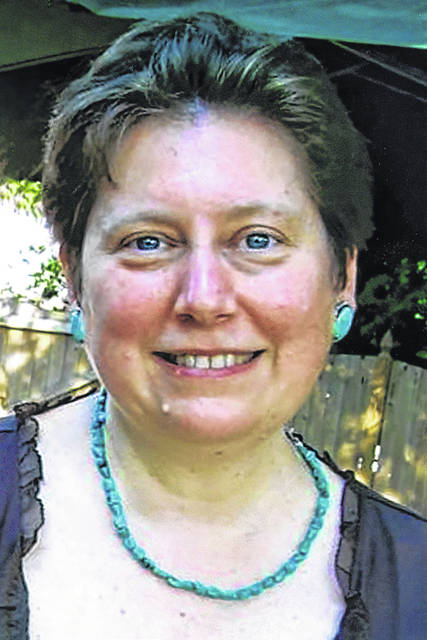
During a terrifying health crisis in the past, artists created masterworks we still talk about today.
“Pandemics, Politics and Pictures: Italian Art and the Black Death” was the 10th lecture in a series presented by Ohio Wesleyan University.
On Wednesday, Carol Neuman de Vegvar, OWU professor of fine arts, compared art to living things, in that art may evolve to respond to cultural changes, may attempt to or succeed in transforming its culture, and some art has gone extinct.
“The COVID pandemic has just started to produce visual art,” Neuman de Vegvar said. “Just in the past few weeks an Instagram site has popped up called the COVID Art Museum, which digitally exhibits new work by artists producing new pieces in response to the pandemic and quarantine.”
The COVID Art Museum will soon have its own website.
In addition, humorous COVID references have also been added to famous works of art, such as the Mona Lisa wearing a cloth face mask, “intending to give the viewer some relief from stress and isolation.”
While individuals are welcome to look at art from the point of view they bring to it, she said, there is also the context of the times and location of the artist.
“Every work of art is an opportunity to find out more. There’s always a door open. Enjoy it, but also be welcome to drill down. These are not contradictory,” Neuman de Vegvar said.
Looking back at the Pandemic of 1918, Edvard Munch did a self-portrait of himself as a flu patient, and photojournalists documented the crisis. The AIDS crisis, in contrast, presented more activist works of art.
Neuman de Vegvar said some art in the time of the Black Death (bubonic plague), such as the famed 100-tale Decameron, used artistic license and stock phrases, and they were not meant to be taken as literal chronicles and eyewitness accounts.
She noted that in the years leading up to 1348, there were natural and manmade calamities among the republics in present-day Italy. There was also a fear of imminent eternal judgment, and the contagion struck many as the wrath of God. The rumor-mongering and social upheaval resumed as the plague returned in renewed waves in 1363 and 1374.
After the plague, the Renaissance period began, and the tragedy faded from memory, and arts focused more on the world of nature.
Neuman de Vegvar showed slides of works by artists such as Bonaiuti, Giotto and Orcagna. These works in cathedrals are often allegorical, and portray subjects such as the Triumph of the Church as depicted by the Dominican order. The works often take the form of detailed wall paintings (done from top-to-bottom) in the ornate, sacred Florentine buildings, many of which can be visited. She said digital images can’t substitute for seeing the works live.
Most painters and sculptors of the time of the pandemic in what is now called Italy worked on commission, working to the specifications of the wealthy patrons requesting the piece.
“What we see here is art speaks in a variety of ways to an individual patron’s aims and alliances,” she said. For example, following the Black Death, more violent scenes began appearing in Franciscan refectories.
Some said money meant for the poor was misappropriated for the wealthy on religious works in chapels, what Neuman de Vegvar called an early version of fake news. Even the writer Vasari quoted the false narrative two centuries later in his “Lives of the Artists.”
“Everybody loves a scandal, particularly a misuse of funds, makes it particularly juicy,” Neuman de Vegvar said, noting that Vasari was found to be wrong only 20 years ago.
“What are the takeaways? First, cultures do not respond monolithically in visual expression or otherwise in moments of disaster. Human beings are neither lemmings or honeybees, and as individuals, subgroups and institutions, we respond to crisis often deliberately and with intent in ways that reflect our particular position with the moment.
“Second, some of the responses to the Black Death in Italy can be useful in today’s pandemic. We are not the first to circulate fake news … to divide into social and political factions in a time of epidemic … but the Black Death can also provide some examples of how not to do it, to remember that we really are in this together.”
Wednesday’s hour-long virtual class concluded week five of a 10-week, free online course called “We’re in This Together: An Interdisciplinary Exploration of the Coronavirus Pandemic.” Taught by 24 Ohio Wesleyan faculty members, the course is open to students and the public alike.
“You can see all that terrible suffering, and all the panic produced, that too had an end, and so shall this. In a strange and contradictory way, I find this kind of hopeful, because I know what comes next historically,” Neuman de Vegvar told course co-director Kira Bailey in response to her question about how past pandemics relate to the current coronavirus crisis.
OWU spokespersons said more 1,200 people are participating in the class, and more than 350 people are taking part in a Facebook COVID-19 Class Discussion Group.
For more information about OWU’s “We’re in This Together” course, visit www.owu.edu/COVIDclass.


